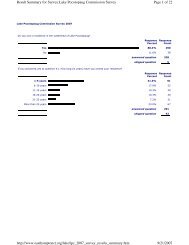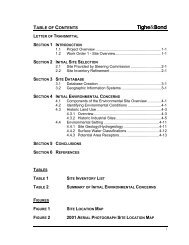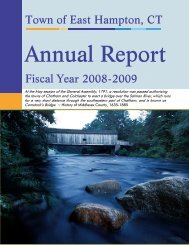Lake Pocotopaug Lake and Watershed Restoration Evaluation ...
Lake Pocotopaug Lake and Watershed Restoration Evaluation ...
Lake Pocotopaug Lake and Watershed Restoration Evaluation ...
You also want an ePaper? Increase the reach of your titles
YUMPU automatically turns print PDFs into web optimized ePapers that Google loves.
Surface water TP loading can also be calculated by using a load coefficient. Thistechnique was used by the AHLAC <strong>and</strong> the range of values was tighter than the rangecalculated using actual data (as described in the previous paragraph). A load coefficientof 0.3 – 0.5, depending on l<strong>and</strong> use was used, in previous investigations, predicting a TPload of 232 – 480 kg/yr.Additionally, a mass balance equation (using both whole lake <strong>and</strong> eplimnion areas <strong>and</strong> a75% retention rate) was to estimate the TP load. Mass balance results provide a TPrange of 280 – 720 kg/yr.Waterfowl contributions were based an estimated 100-200 bird/years multiplied by aphosphorus concentration of 0.2 kg/bird/yr (Brezonik, 1973; Manny et al., 1994).Waterfowl are estimated to provide 6 to 11 percent of the total phosphorus load to <strong>Lake</strong><strong>Pocotopaug</strong>. Fugro (1993) estimated that waterfowl contribute 43 kg/yr (about 4% of thebudget estimated by Fugro).Internal loading was calculated based on the expected remaining sediment releasefollowing alum treatment. The 2002 in-lake data clearly indicate that internal loading<strong>and</strong> the rate of contribution were greatly reduced by the alum treatment. Therefore, anadjusted rate of 0.5 mg/m 2 /day (typical of oxic sedments in other lakes studied by ENSRstaff) was applied to the untreated lake area for a period of 90 days (summer), resultingin an annual load of 62 kg/yr, or 12 – 22 % of the current TP budget.8.4 Tributary <strong>and</strong> Storm Drain LoadingA method for determining the phosphorus load from the watershed used in the “L<strong>and</strong>Use <strong>and</strong> Phosphorus Input to <strong>Lake</strong> <strong>Pocotopaug</strong>” by the AHLAC in 1995 was repeatedusing median 2001 stormwater data <strong>and</strong> is presented in Table 19.Additionally, the relative phosphorus load was calculated using median stormwaterconcentrations in 2001 (Table 20). Table 20 is sorted by percent relative loadcontribution. Hales, Bay, O’Neils, <strong>and</strong> Christopher Brooks contribute the bulk of the TPentering <strong>Lake</strong> <strong>Pocotopaug</strong>. However, excessive phosphorus loading is prevalentthroughout the watershed.<strong>Lake</strong> <strong>Pocotopaug</strong> <strong>Restoration</strong> <strong>Evaluation</strong> 85May 2002







